There and Back Again…
January 19, 2011Eliaichi Kimaro’s Hard Truths
by Lindy West

The film (which will screen at the San Diego Black Film Festival this month) opens with sticks and hands, sticks and hands—anonymous human hands bending and weaving pliable sticks into a round, brown, beehive-shaped structure, which we will later learn is a traditional hut of the Chagga people from the slopes of Mount Kilimanjaro. In this opening sequence, the hut is just that—an anthropological artifact from an impenetrably distant place, something to be respected but not known, a mute piece of the poetic idea of Africa. It’s quaint. By the film’s end, the hut is everything.
“I am a first-generation American,” Kimaro explains in voice-over. “Mom and Dad are from opposite ends of the globe. An interracial, bicultural couple.” Her mother is from Korea, her dad is from Tanzania, and they met in school in the United States (their love story and subsequent careers at the IMF and the World Bank constitute a fascinating chunk of the film). Growing up, Kimaro spent every summer in Tanzania with her Chagga relatives, but, she says, “that connection was hazy.” She was welcome, but she was foreign, and that wasn’t easy: “Every summer in Tanzania was a reminder that this kinship I bragged about to my American friends existed only in my imagination.” That disconnect is where A Lot Like You begins.
In person, Kimaro radiates warmth and honesty—her presence crowds all potential awkwardness out of the room. You want to hug her. A Lot Like You has been an eight-year process, she explains to me over coffee in Seward Park. With no filmmaking experience but a nagging feeling that she needed to tell her story, she enrolled in a beginner’s class at 911 Media Arts Center. Then, in 2004, she quit her job as a domestic-violence counselor, packed up her equipment, and moved to Tanzania for nine months, not knowing what she would find.
From Kimaro’s narration in the film:
We tried for months to capture what we thought of as Chagga culture. Storytelling, ancestral worship, traditional healing practices—and in return, everyone around us performed their own version of Chagga culture. One they thought that I, as a tourist, would want to see. And while I see myself reflected in the faces around me, I realized that to them I am just an American. With nothing but my name connecting me to this world.
This early footage sets the mission for the way A Lot Like You eventually unfolds—it’s truth, but it’s manufactured truth, tailored to the person Kimaro’s relatives think she is. A feedback loop of assumptions and distance and the awkward limitations of cultural relativism. There had to be more to it than that.
Kimaro returned from Tanzania with 80 hours of footage and no idea how to edit it. Based on the strength of a four-minute trailer she put together, editor Eric Frith (The Heart of the Game) came on board. Vashon Island songwriter Pete Droge, whom Kimaro calls “the king of bittersweet melancholy,” agreed to do the music (he’s releasing a soundtrack at www.puzzletreemusic.com). After a long, slow process, they screened an early cut at Northwest Film Forum and received some disheartening but formative feedback from a local filmmaker: “He said, ‘It’s perfectly lovely, it’s Seattle-nice, but it has no heart.’ And that was the real beginning of the final arc of the movie.”
Kimaro went for it. She rewrote the movie completely. She delved into issues of abuse in her own life and, amazingly, drew devastatingly similar admissions out of her silent, stoic aunts (“I was shocked at how bizarrely my life seemed to prepare me for that moment with my aunts”). She confronted her parents about all of it (Kimaro’s parents, by the way, are two of the most charming humans ever committed to film). All of it went into the movie, and the result is difficult, loving, and riveting. “We went through so many different versions,” she says. “And a piece of all of them is still there. That’s why the film feels so layered.”
The hut sits in her parents’ yard at their home in Dar es Salaam. Almost none of the Chagga live in traditional huts anymore, but Kimaro’s father wanted one—an artifact of a distant childhood in a world that he left behind and then returned to, changed. The hut is him and it is not him, a historical tether in a modern space. It’s comforting and complicated. One gets the feeling that A Lot Like You is Eliaichi Kimaro’s Chagga hut.
And more than that, of course. Says Kimaro: “It’s my story, it’s the story of my family, but it’s more than that. My hope is that everyone will be able to take a piece of this film and relate to it. That it can be a springboard for community engagement, a tool for something bigger, rather than just a thing in itself—to get people thinking and talking about female genital mutilation, gender violence, mixed-race issues, multicultural families, the search for identity. That’s my hope.” ![]()

4 Responses to There and Back Again…
Pingback: The Stranger recommends “A Lot Like You” | alotlikeyoumovie
Pingback: 2011 in review | alotlikeyoumovie